|
Pest
Surveillance: Thrips (Scirtothrips dorsalis),
mite (Oligonychus mangiferus) (Rhaman and
Sapra) and leaf weevils (Rhynchaenus mangiferae Fab.)
are emerging as serious pests. The incidence of thrips
on fruits (lemon size) was highest (24.5%) in
Banganapalli and < 5% in Totapuri. Thrips infestation
among dropped fruits ranged from 12-15%. The fruit borer
(Citripestis eutraphera Meyrick) recorded
enhanced infestation of 4.5% in Alphonso and 1-2% in
Banganapalli. The unopened buds of Alphonso were found
to be infested with blossom midge (Procantarina sp.) to
the extent of 15-28% at different periods. Both male and
female flowers were affected. The mite infestation on
leaves prevailed almost throughout the year, peak during
July – August. Among hoppers, Amrasca splendens Ghauri
dominated in vegetative phase while Idioscpus nitidulus
(Walker) was the dominant species (>90%) during blossom
period distantly followed by I. nagpuriensis Pruthi (7%)
across the varieties.
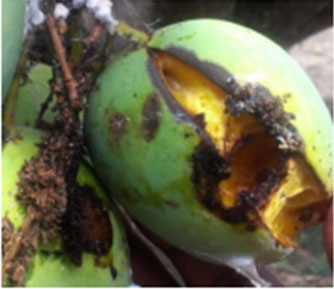 |
|
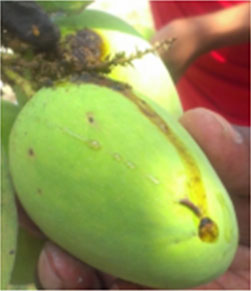 |
| Mango fruit borer
infestation (Citripestis eutraphera) |
|
Management of hoppers and thrips
Entomopathogens, azadirachtin
and insecticides were evaluated for the management of
leafhoppers (Idioscopus sp.), and thrips (Scirtothrips
dorsalis). Four sprays of oil formulation of
Metarhizium anisopliae (0.5 mL/l) at weekly interval
resulted in 83.5% reduction in hopper population
compared to 87.2% with two applications of imidacloprid
@ 0.25 mL/l. It was also effective against thrips and
brought 60% reduction in thrips population.
Healer cum Sealer for the management of mango stem borer
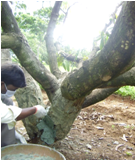 Healer
cum Sealer for the management of mango stem borer Healer
cum Sealer for the management of mango stem borer
• The solution is permanent (meaning there is no
reinfestation in the same season)
• The formulation completely blocks the unseen holes and
as well visually seen holes
Specific Benefits:
• The tree is rejuvenated with nutrition
• The formulation can be tried even under mild rains
(However immediate heavy rains may wash off the treated
tunnels post treatment; after 48 hr the treatment is
rain-fast)
• The formulation developed is cost effective
Mesh trappig technique
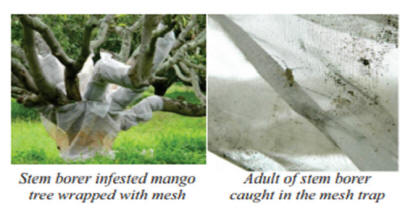 A
simple mesh trapping technique was standardised to
collect and monitor tree trunk borers. With this
technique, it was found that besides trunk borer
(Batocera rufomaculata De Geer), two other species of
Cerambycidae viz., Gleneam ultiguttata Guerin-Meneville
and Coptopsa edificatory (Fab.) were infesting mango. It
also helped in recording the precise timing of adult
emergence. The trunk borer (B. rufomaculata)
was the first to emerge and the maximum emergence (4/10
trees) was recorded during second week of July. The next
species to emerge was G. multiguttata in the fourth week
of June followed by a buprestid and C. aedificator. Of
these, G. multiguttata was numerically the most dominant
species (mean 9.0/tree). B. rufomaculata emerged out
from trunk of the mango tree while the other three
species had emerged out of lateral branches. There was a
positive correlation between stem borer infestation and
tree age (+0.68). The lowest point of the occurrence of
borer was 15 cm and the highest was 72.5 cm. Maximum
number of bored holes was recorded at the first
branching junction. The variety Alphonso and Langra had
the highest infestation (20-25%) while Banganapalli had
the lowest. Infestation was significantly more (42%) in
high density plantation (3 x 3 m) than normally spaced
trees. A
simple mesh trapping technique was standardised to
collect and monitor tree trunk borers. With this
technique, it was found that besides trunk borer
(Batocera rufomaculata De Geer), two other species of
Cerambycidae viz., Gleneam ultiguttata Guerin-Meneville
and Coptopsa edificatory (Fab.) were infesting mango. It
also helped in recording the precise timing of adult
emergence. The trunk borer (B. rufomaculata)
was the first to emerge and the maximum emergence (4/10
trees) was recorded during second week of July. The next
species to emerge was G. multiguttata in the fourth week
of June followed by a buprestid and C. aedificator. Of
these, G. multiguttata was numerically the most dominant
species (mean 9.0/tree). B. rufomaculata emerged out
from trunk of the mango tree while the other three
species had emerged out of lateral branches. There was a
positive correlation between stem borer infestation and
tree age (+0.68). The lowest point of the occurrence of
borer was 15 cm and the highest was 72.5 cm. Maximum
number of bored holes was recorded at the first
branching junction. The variety Alphonso and Langra had
the highest infestation (20-25%) while Banganapalli had
the lowest. Infestation was significantly more (42%) in
high density plantation (3 x 3 m) than normally spaced
trees.
Stem borer
diversity
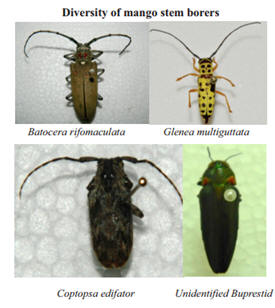
|